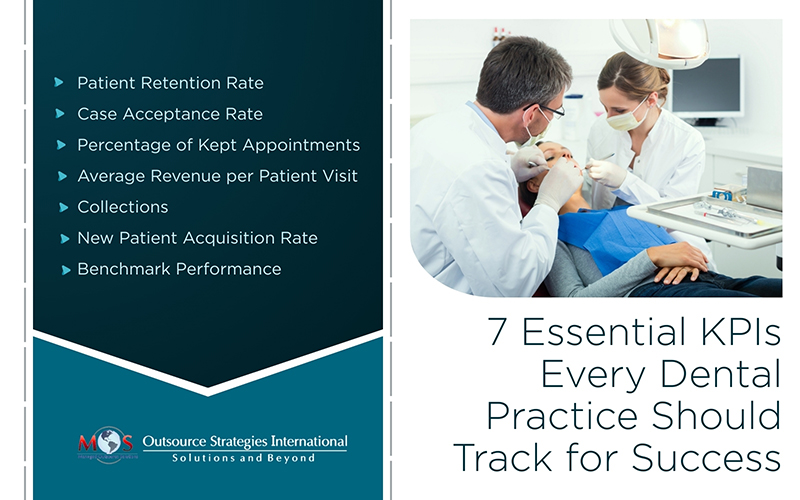Effective dental revenue cycle management (RCM) is essential for any dental practice, and tracking the right key performance indicators (KPIs) plays a key role in this matter. From monitoring collections to analyzing case acceptance rates, dental billing metrics provide valuable insights into financial health, operational efficiency, and patient retention. By leveraging dental RCM services, practices can streamline billing processes, reduce claim denials, and optimize revenue cycles. In this post, we’ll explore the essential dental practice financial metrics that should be tracked to achieve billing success and long-term profitability.
Struggling with claim denials and delayed payments?
Maximize revenue with our expert dental RCM services!
7 Key Performance Indicators in Dentistry
Patient Retention Rate
This KPI measures the percentage of patients who return to your practice for routine checkups, treatments, and follow-ups. For example, an 85% patient retention rate means that 85 out of every 100 patients return regularly for preventive care, restorative treatments, and elective procedures like teeth whitening. A high retention rate means you have satisfied patients who trust your practice.
Tracking patient retention rate helps you identify areas for enhancing patient satisfaction and fostering long-term loyalty. This usually includes working on providing a personalized patient experience, effective appointment scheduling and follow-ups, consistent quality of care, and flexible payment options. Focusing on these strategies can enhance patient satisfaction and loyalty, and help you build a strong patient base.
Case Acceptance Rate
Case acceptance rates reflect the percentage of patients who agree to proceed with recommended treatment plans. A high acceptance rate indicates strong communication, effective patient education, and trust in your expertise. Monitoring this KPI helps identify obstacles in the treatment planning process, allowing you to make necessary adjustments to improve patient satisfaction and financial performance. Enhancing this metric can lead to significant revenue growth and long-term practice success.
Building strong patient trust is essential for high case acceptance. Patients need to see you as a knowledgeable expert who genuinely understands them. This includes recognizing their values, addressing their unique health circumstances, and providing the care they need in a way that addresses their concerns and aligns with their preferences.
Percentage of Kept Appointments
The percentage of kept appointments tracks the proportion of scheduled visits that patients attend. This KPI offers valuable insights into patient behavior, scheduling efficiency, and overall engagement. By monitoring this metric, dental practices can refine their appointment management strategies, minimize no-shows, and strengthen patient retention, ultimately improving both operational efficiency and patient satisfaction.
Average Revenue per Patient Visit
This KPI measures the average revenue generated by each patient seen in the practice. Measuring average revenue per patient visit provides valuable insights into your practice’s profitability and help you identify opportunities for increasing revenue. For example, you can recommend higher-value treatments, such as fluoride applications, sealants, or teeth whitening, when appropriate, improving outcomes and increasing patient collections. Additionally, understanding revenue per visit allows you to identify underutilized services and ensure patients receive comprehensive care that benefits both their oral health and your practice’s bottom line.
Collections
Collections represent the revenue received from patients and insurance providers. This key performance indicator (KPI) is crucial for managing cash flow, identifying payment trends, and ensuring your practice is properly reimbursed for services rendered. With insurance claim tracking and monitoring of collections, dental practices can detect inefficiencies in billing and payment processes, allowing them to take corrective action to improve financial stability. Tracking both production (the total value of services provided) and collections (the actual revenue received) is essential for effective financial management.
New Patient Acquisition Rate
Acquiring new patients is crucial for the growth and expansion of a dental practice. This metric measures the number of new patients the practice acquires each month. By closely monitoring the rate at which new patients are acquired, you can gain insights into the effectiveness of your practice’s marketing and advertising efforts, referral program, and overall patient satisfaction. This information can help you refine your marketing efforts and enhance patient engagement.
Benchmark Performance
Comparing your KPIs with revenue cycle benchmarks for dental practices allows you to gauge your practice’s market position and identify areas for improvement. This competitive analysis helps you focus on key performance areas to maintain a strong presence in the industry. Additionally, benchmarking enables you to set realistic, data-driven goals and develop targeted strategies to achieve sustainable growth and success.

Maximize Revenue with Expert Dental RCM Support
Partnering with a specialized dental billing company helps ensure accurate and timely claim submissions, reducing denials and enhancing reimbursements for a more efficient dental revenue cycle. By leveraging professional dental billing services, your practice can boost cash flow, reduce administrative overhead, and achieve revenue cycle management (RCM) success—while staying focused on delivering quality patient care.
Boost your practice’s cash flow with accurate claim submissions!




